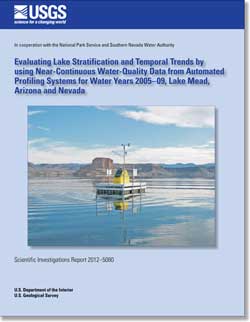 Abstract Abstract
The U.S. Geological Survey, in cooperation with the National Park Service and Southern Nevada Water Authority, collected near-continuous depth-dependent water-quality data at Lake Mead, Arizona and Nevada, as part of a multi-agency monitoring network maintained to provide resource managers with basic data and to gain a better understanding of the hydrodynamics of the lake. Water-quality data-collection stations on Lake Mead were located in shallow water (less than 20 meters) at Las Vegas Bay (Site 3) and Overton Arm, and in deep water (greater than 20 meters) near Sentinel Island and at Virgin and Temple Basins. At each station, near-continual depth-dependent water-quality data were collected from October 2004 through September 2009. The data were collected by using automatic profiling systems equipped with multiparameter water-quality sondes. The sondes had sensors for temperature, specific conductance, dissolved oxygen, pH, turbidity, and depth. Data were collected every 6 hours at 2-meter depth intervals (for shallow-water stations) or 5-meter depth intervals (for deep-water stations) beginning at 1 meter below water surface.
Data were analyzed to determine water-quality conditions related to stratification of the lake and temporal trends in water-quality parameters. Three water-quality parameters were the main focus of these analyses: temperature, specific conductance, and dissolved oxygen. Statistical temporal-trend analyses were performed for a single depth at shallow-water stations [Las Vegas Bay (Site 3) and Overton Arm] and for thermally-stratified lake layers at deep-water stations (Sentinel Island and Virgin Basin). The limited period of data collection at the Temple Basin station prevented the application of statistical trend analysis.
During the summer months, thermal stratification was not observed at shallow-water stations, nor were major maxima or minima observed for specific-conductance or dissolved-oxygen profiles. A clearly-defined thermocline and well-defined maxima and minima in specific-conductance and dissolved-oxygen profiles were observed at deep-water stations during the summer months. Specific-conductance maxima were likely the result of inflow of water from either the Las Vegas Wash or Muddy/Virgin Rivers or both, while the minima were likely the result of inflow of water from the Colorado River. Maxima and minima for dissolved oxygen were likely the result of primary productivity blooms and their subsequent decay.
Temporal-trend analyses indicated that specific conductance decreased at all stations over the period of record, except for Las Vegas Bay (Site 3), where specific conductance increased. Temperature also decreased over the period of record at deep-water stations for certain lake layers. Decreasing temperature and specific conductance at deep-water stations is the result of decreasing values in these parameters in water coming from the Colorado River. Quagga mussels (Dreissena rostriformis bugensis), however, could play a role in trends of decreasing specific conductance through incorporation of calcite in their shells. Trends of decreasing turbidity and pH at deep-water stations support the hypothesis that quagga mussels could be having an effect on the physical properties and water chemistry of Lake Mead. Unlike other stations, Las Vegas Bay (Site 3) had increasing specific conductance and is interpreted as the result of lowering lake levels decreasing the volume of lake water available for mixing and dilution of the high-conductance water coming from Las Vegas Wash. Dissolved oxygen increased over the period of record in some lake layers at the deep-water stations. Increasing dissolved oxygen at deep-water stations is believed to result, in part, from a reduction of phosphorus entering Lake Mead and the concomitant reduction of biological oxygen demand.
|